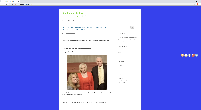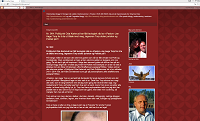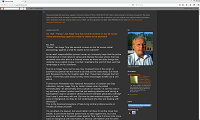 |
 |
 |
Who Do You Say That He Is?
One evening Jesus was in a boat with his disciples crossing the Sea of Galilee. A sudden, violent storm enveloped them, high waves filled the boat with water and the disciples were terrified. Jesus, however, remained asleep. They awakened him and said, “Don’t you care that we are going to die?” Of course Jesus cared about them, after all, he was on the boat with them. He arose, rebuked the storm, and the turbulent sea calmed right down. The terrified disciples said among themselves, “…What manner of man is this, that even the wind and the sea obey him?” They had never seen anyone act with such fearlessness and such authority, nor wield such godly power. In the Greek text, the Apostles’ question reads: “Who then is this One?” Indeed, this is the question of the ages, and one that every person must answer for himself.
Some time later, as his ministry developed and his fame grew, Jesus asked his disciples a question of his own: “…Who do people say the Son of Man is?” (Matt. 16:13). After they reported to him the various opinions circulating among the people concerning who they thought he was, Jesus asked them: But what about you? Who do you say that I am? Peter’s response was “…You are the Christ, the Son of the Living God.” Jesus affirmed that not only was that the correct answer, but that Peter knew it because God Himself had revealed it to him.
His question continues to hang in the air even two thousand years later, and it is the question that one day every man and woman will be required to answer. Why? Because God “…has set a day when he will judge the world with justice by the man he has appointed” (Acts 17:31a). There is no more important quest facing mankind than finding out the true identity of Jesus Christ and understanding the significance of his life. The issue is a matter of life and death, both in regard to the quality of one’s life now, and his future eternal destiny.
Suffering and Glory
The coming of this Man was first announced in Genesis 3:15, and at that time the two principal aspects of his life were described: suffering and glory. The entire scope of Christological history (that is, “the study of Christ”) revolves around these two themes. The multiplicity of misconceptions about him also can be distilled into this paradigm. In general, people have either demeaned him or elevated him inappropriately. Another way to state the problem is that people have either prevented him from truly suffering or prevented him from being truly glorified. Either way, the true significance of his identity and accomplishments has been distorted, and therefore the essence of the Christian Gospel compromised.
At Jesus Christ’s first coming to the Jews, many wrongly expected the Messiah to be more than he was at that time. Their one-sided theological conception of him as the conquering, glorified King kept them from recognizing and appreciating who he was and what he was sent to do. There was no room in their theological inn, so to speak, for him to be the suffering Savior of mankind, and when he was manhandled and crucified, many were offended at him and thought him to be a pretender to the throne of David. On the other hand, others saw him only as the bastard son of Joseph, a mere man who died the death of a common criminal.
Subsequent misconceptions about Jesus Christ have run the gamut, either demeaning or exalting him according to man’s imagination. Untethered to biblical truth, these musings of men have included bastard child, extraterrestrial, mushroom cult leader, charlatan, mystic or angelic being. Many Christians have been taught that Jesus must be elevated to the status of a “God-man.” Others think of him as just a “good man.” Some people believe that we cannot really know if there even was an historical figure called Jesus of Nazareth, while others believe him to be a mythological creation. In fact, every Christological position of which we are aware, at some point either artificially elevates or ignorantly degrades the Lord Jesus. Our quest, then, is to find the true and balanced perspective of this remarkable man who in our view is the very focal point of human history. To do so, we will find that many traditional ideas will have to be jettisoned in favor of the clear testimony of the only credible source of information about this Jew from Galilee who was called in his own tongue, Yeshua ha Mashiyach, Jesus the Messiah.
A Spiritual Battle
The battle over the true identity of Christ is a very spiritual one with high stakes for mankind. Unquestionably, this Jesus of Nazareth has been the object of more speculation and demonic assault than any other person in the history of man. It is no accident that the name “Jesus Christ” springs spontaneously from the lips of all kinds of people, from the pious priest to the construction worker who has just dropped a cinder block on his foot. Even when Jesus Christ is rejected as an object of faith, he is chosen as an object of derision.
This is predictable based upon what the Bible says is really going on around us. In fact, a major theme of Scripture concerns the ever-raging battle between the true God, the Father of Jesus Christ, and the false god, the “god of this age,” whom we now know as Satan, the Devil. He is a shrewd general, directing the main thrust of his attack upon the most vital truths in God’s Word. The chief object of his hatred is The Man who now sits at the right hand of God. Accordingly, his primary goal is to blind the minds of men to the truth of the glorious Gospel about Jesus Christ (2 Cor. 4:3 and 4). It is sad to say that by a number of means he has been very successful in at least distorting, if not totally obscuring, the simple truth of who Jesus Christ is.
As Satan once inspired the evil King Jehoiakim to cut up and then burn the Word of God written by Jeremiah (Jer. 36), so he inspired evil men to destroy the Living Word, Jesus Christ. His relentless assault continues unabated, attempting to undermine the authority and credibility of the written Word of God that makes known the Living Word. His assault is primarily carried out on the battlefield of the mind. Today, we see fewer and fewer Christians who actually honor the written Word of God as their only rule of faith and practice. Instead, too many Christians give lipservice to biblical authority but in reality rely upon other standards for faith: the historic position of the Church, the testimony of their favorite preachers, the “leading of the spirit,” their own feelings, etc.
But as Satan failed to destroy either the scrolls of Jeremiah or the Living Word, Jesus Christ, so he has failed to destroy the written Word of God. In fact, after the original scroll was destroyed, God told Jeremiah to dictate more words than the first scroll contained. Likewise, after Jesus Christ was killed, God raised him from the dead, highly exalted him and gave him the authority to give to all those who believe on him the power to live like he did, doing the works that he did. Thus, Jesus Christ now exerts far more influence on the world than he did when he walked the earth.
In light of this spiritual battle, it is certainly not surprising that through the centuries the Christian Church could be seduced by Satan’s subtlety from the simplicity that is in Christ (2 Cor. 11:3). This is why for the better part of nineteen hundred years the “historic” Christian Church has unwittingly clung to and promoted “a different gospel” about “a Jesus other than the Jesus we preached” (2 Cor. 11:4). The other “Jesus” of historical Christian orthodoxy is a mystical “God-man” who existed before he was born. In this book, we will do our best to provide an alternative to this traditional position, one that we believe fits the evidence and logic of Scripture as a whole. We sincerely believe that a careful, logical and objective consideration of the evidence will lead the reader to the same conclusions that we have reached.
Resetting the Cornerstone
Jesus Christ is, by the agreement of all Christians, the subject of the Bible from Genesis 3:15 to Revelation 22:21. He is the very cornerstone of the edifice of biblical teaching. In Ephesians 2:20 and 1 Peter 2:6, he is called the “chief cornerstone.” 1 Corinthians 3:10 and 11 make it very clear that he is also the foundation for the building of the Church. The cornerstone sets the angles and dimensions for an entire building, which can rise only as high as the foundation and cornerstone permit. If the corner is cut inaccurately, the walls of the building will be skewed and its height will be limited. 2 Timothy 2:15 (KJV) cautions the student of the Bible to “rightly divide” (orthotomeo) the Word of truth. This Greek word, derived from orthos, “right” or “straight,” and temno, “to cut,” literally means a “right or straight cutting.”
Cutting the cornerstone accurately, therefore, is of the greatest importance for biblical understanding and exegesis and the furtherance of the Christian Gospel worldwide. We must therefore be diligent and skillful in the choice and application of the tools we will use to accomplish this crucial task. As we will attempt to demonstrate, the history of the Church’s Christology is a tale of misdirected zeal and the use of inappropriate tools, in particular theological reflection, Gnostic mysticism and Neoplatonic speculation. Diligent, even heroic effort has been made to rationalize the historically “orthodox” position, despite much contrary evidence from the scope of the Bible and logic. [1] In our view, the result is a view of Christ that cannot stand up to rational or Scriptural scrutiny, thus emboldening the critics of Christianity, notably Muslims, Jews and intellectuals. Indeed, we speculate that for every person who has embraced the orthodox view and become a Christian, there is at least one who has rejected Christianity because he or she could not believe in its central teaching of the “divinity of Christ.” It is for this reason, and because we believe that the truth honors both God and Jesus, that we propose resetting the cornerstone for the Christian faith in a more biblically tenable and supportable position. We also believe that the truly biblical understanding of Christ’s identity is imperative to strengthen the faith of Christians against the onslaughts of the modern and “post-modern” world.
As for the true identity of Jesus Christ, the thesis of this book is as follows: The Jesus of Scripture is the “Last Adam” whom God created as the only possible remedy for the problem of sin and death brought on by the First Adam. What Adam was before his fall is what Jesus was, a man made the way man was intended to be. God’s Word tells us that Jesus was “…made like his brothers in every way….” It says he was touched with the feeling of our infirmities. It says that he was tempted in the same ways we are. It says that he was tired, hungry and thirsty and that he experienced the full range of human emotions. As the “Last Adam,” Jesus Christ truly was a one-hundred-percent human being.
As human beings with limited ability and perception, it is impossible for us to accurately conceive of, or identify with, the eternal God whose throne is the heavens and footstool is the earth (Isa. 66:1). A blind man might as easily describe the color “yellow.” We can, however, conceive of and identify with The Man Jesus Christ, who exemplified what God is all about. Jesus Christ perfectly represented his heavenly Father. How? By always saying what God would have said and by doing what God would have done. Remember such statements of Jesus as: “My doctrine is not mine, but His who sent me”; “The Son can do nothing of himself, but only what he sees the Father do”; “I always do my Father’s will.” Because Jesus perfectly lived the Word and will of God, he could say, “If you’ve seen me, you’ve seen the Father.”
The converse is also true—if Jesus Christ is distorted, misrepresented or obscured, the identity of his Father, the “only true God,” is also obscured. This is why the title of this book is One God & One Lord, because knowing the true identities of both God and Christ hinges on our correct understanding and usage of biblical language. The Bible is very clear in this regard: there is only One God, a unitary personal being, and this God is not Jesus Christ, who is His Son. And there is only one Lord, a separate being who is not God, his Father. He is the Lord Jesus Christ.
1 Timothy 2:5 tells us that “…there is one God and one mediator between God and men, the man Christ Jesus.” Jesus said that no one could truly know the Father except by coming through him. Jesus is “…the way and the truth and the life….” He is the way (the Greek word means “the road”) to God. He is the truth that marks that road, and he is the life found by those who choose to follow the road. Thus, if we are to know, love, honor and obey the Creator of the heavens and the earth, it is imperative that we know the one He sent to reveal Himself, the Lord Jesus Christ. In fact, it is a matter of life and death, for he is the only way to the one true God. We believe that when Jesus’ true identity is skewed, those desiring to follow him on the road of life may find themselves disoriented and frustrated. We find it an inescapable conclusion that an erroneous concept of who Jesus is basically leaves Christians with a “you-can’t-get-there-from-here” attitude in their quest to be like him. And after all, that is to be the goal of every Christian—to be like him. Any doctrine of Christ that subverts, hinders or obscures this goal in any way should be held suspect and finally discarded.
So how are we to come to know the truth about who Jesus was, and is? There is no way to know Jesus Christ but to rely on the Bible, the written Word of God, and let God tell us the truth about His only begotten Son. Our entire argument rests upon this premise: the Bible is the revealed Word and Will of God. If it is anything less than that, our argument will fall to pieces. But we believe there has been an abundance of evidence of the precise inspiration of Scripture that will support this premise.
Ultimately, our goal is to rest upon the authority of the testimony of the biblical text itself so precisely that if the Bible is right, we will be right, and if the Bible is wrong, we will be wrong. If our interpretation of the Bible is wrong, we will take full responsibility for it and be willing to stand corrected. Our goal is not to be right in order to make others wrong, and thereby make ourselves look good. Our goal is to assist the reader in heeding the two great biblical commandments:
Mark 12:29-31 (NRSV)
(29) Jesus answered, “The first is, ‘Hear, O Israel: the Lord our God, the Lord is one;
(30) you shall love the Lord your God with all your heart, and with all your soul, and with all your mind, and with all your strength.’
(31) The second is this, ‘You shall love your neighbor as yourself.’ There is no other commandment greater than these.”
This love for God and Christ will reveal itself in loving obedience, and this obedience will enable Christ to reveal himself to us. Consider the following verse:
John 14:21 (NRSV)
They who have my commandments and keep them are those who love me; and those who love me will be loved by my Father, and I will love them and reveal myself to them.”
To know the Lord Jesus Christ, one must first have the Word of God, that is, understand it. Then one must also put the Word into practice, that is, obey it. To those who do both, the Lord Jesus will make himself real. Knowing the Lord Jesus is the key to loving him, and loving him is the key to serving him. Serving him is the key to a joyous and fruitful life.
In this book, we will allow the Word of God to magnify to us its main subject, Jesus Christ. In order for it to magnify the Lord Jesus to us, we must be careful to pay close attention to the signposts of biblical terminology. If we use words the way God does in His Word, we will not drift into the theological shallows. The Word of God says to be cautious not to add to nor subtract from its words. Extra-biblical vocabulary can easily introduce extra-biblical concepts that are often contradictory to God’s original intent. A classic example is the introduction of the Greek word homoousian at the council of Nicaea, which we will be exploring in Chapter 18 on the rejection of Scripture and logic. Also, in many cases, equivocation of important terms has led the way to mysticism and incomprehensible dogmas. Therefore, defining words accurately according to their biblical usage will be a major preoccupation of this book.
We will be focusing on the identity of Jesus Christ and his relationship with God. Other books could be written on the subject of his work, which we will not be focusing on in this book. The foundation for understanding and appreciating Christ’s accomplishments lies in properly discerning his identity as “the Last Adam.” We are also limiting our historical overview to those ideas, developments and influences that directly bear upon the formation of Christian doctrine concerning his identity and the role that this doctrine has had in Church history. In particular, we will argue that because Christian orthodoxy adopted the means and methods of mysticism, the resulting rejection of reason became a major hindrance to individual spiritual growth and liberation.
In fact, we believe that the historical record shows that the Christian church became an authoritarian and monarchial hierarchy held in place by a set of unintelligible doctrines that needed an elite class of priests to interpret to the masses. The average Christian believer was thus held captive to unquestionable dogmas replete with mystery and paradox until the dawning of the Reformation began to make available intellectual freedom. This book is in line with a historical trajectory begun in the 14th century by John Wycliffe, who began the process of retrieving the Bible from the clutches of spiritual tyrants and returning it to the common sense of the common man. Numerous others since then have reached many of the same conclusions that the reader will encounter in these pages, and most of them have been branded heretics, cultists or blasphemers by the institutional church. Many of them died in pursuit of the truths that the readers of this book will be able to encounter in the safety of modern toleration of religious pluralism and, beyond that, growing indifference to the very idea of “truth.” Nevertheless, like grass poking up through cracks in concrete, the living truth of who Jesus Christ is keeps popping up in the pages of Scripture, out from under centuries of misunderstanding, and despite modern indifference.
Part of our intention in writing this book is to acquaint the reader with the large volume of support for our position extant in the literature of modern biblical scholarship, particularly in the past 20 years. Since it does not support traditional theology, much of this work has not found a popular audience and is therefore not found in standard Christian bookstores. We have endeavored to reduce to footnotes most of the references to the work of these scholars in order not to bog down the reader in often tedious and difficult scholarly jargon. But if the reader will be brave and read the footnotes carefully, he will find almost another book within this book.
Our purpose is to strengthen the faith of those who are dissatisfied with traditional Christology by directing them to recognized scholars who have reached the same conclusions as a result of their research. But our fundamental commitment is not to the intellectual stimulation of our readers with the often detached perspective of the scholar or historian. We write as believers, intent upon learning the truth that might set us free and kindle a fire of desire to further the Gospel of Christ to the ends of the earth. For those who think this book too scholarly, we would plead for grace and understanding and a second or third reading if necessary. In our view, it is the scholars whose theological speculations, often little more than pedantic sophistry, have muddied the waters. To clear things up, we have found it necessary to engage the scholars’ arguments head on, and that often requires a commitment to logical reasoning that some readers may find difficult or tedious.
This book has actually evolved during a ten-year period beginning with a paper titled “Rethinking Christology” that Mark Graeser presented to a group of Trinitarian ministers who were attempting to dialogue with and minister to “cultists.” Mark’s paper forms the basis of several of the chapters of this book. In 1990, John Lynn taught an audio seminar called Jesus Christ: The Diameter of the Ages. Its colloquial and devotional flavor is preserved in a number of sections of the book, which will appeal to those readers who are looking for the more entertaining, readable and less scholarly material. We would particularly recommend for their readability and devotional appeal Chapters 1-3, the last section of Chapter 8, and Chapters 12 and 13. In 1997, John Schoenheit published a work on the Trinity, the highlights of which are represented in Appendix A, that handles the verses often used to argue for the Trinity.
Thus, this book represents a collaboration of many years, several people and much study. A subject this important, and so complicated by tradition and misunderstanding, could hardly be handled by any one person. As a result of the team approach to the writing of the book, the reader may at times sense a “patchwork” aspect to the style, as it reflects our different thinking and writing. We trust that the book as a whole will not be skewed in the direction of any personal style, but reflect our unified desire to “speak the truth in love.”
OVERVIEW
We will now provide an overview of the entire book. In Part 1, we will look at why Jesus Christ is called in Scripture “the Last Adam,” and how each of them was the image of God. We will consider the mechanics and the legality of the redemption that the Savior made available to all men. We will consider what Scripture says about man as “the image of God,” and how Jesus, the perfect Man, is now fulfilling the intended destiny of mankind. Chapter 3 will examine the way Jesus Christ is literally the “purpose of the ages,” and look at his post-resurrection glory.
In Part 2, we will then discuss what the Old Testament tells us about the identity of the Messiah in prophecy from two perspectives. The first is the detailed prophetic portrait that is painted by the Hebrew Scriptures about the coming one, and the second is the way the Jews interpreted these prophecies, which were sometimes ambiguous or difficult to interpret. This helps us understand why even today Jews have difficulty believing that Jesus is the promised Messiah.
Part 3 is a detailed analysis of the Four Gospels, which describe the Savior in person. Chapter 6 is an overview of the Gospels, and explains why there are four. Chapter 7 handles the evidence from the Synoptic Gospels (Matt., Mark and Luke), particularly the view presented there of the apparently “reluctant Messiah” who veiled his identity throughout his life. Chapter 8 will handle the gospel of John in detail, since this is the section of Scripture used to anchor orthodox Christianity. Chapter 9 will look at the relationship between Jesus and the logos and handle the first 18 verses of John, called “the prologue,” which are often misunderstood and misinterpreted.
Part 4 will look at the evidence of the remainder of the New Testament, which clearly identifies Jesus of Nazareth as both Lord and Christ. The book of Acts, the Church Epistles and the book of Revelation have much to say about who Jesus Christ is and his “functionally equal” relationship with his Father.
Part 5 will focus on the practical aspects of who Jesus Christ is, what he is doing now, and our potential to identify with him to the end that we become like him in thought, word and deed. We will close with a look at the true hope of each Christian, that hope made available by the work of Jesus Christ, the only begotten Son of God.
Part 6 is an historical perspective on the development of traditional Christology. First we will look at the phenomenon called “the expansion of piety,” which explains corruptions of the text of Scripture and the historical tendency to elevate the identity of Christ. We will then identify the beginnings of heresy as addressed in the epistles of 1 and 2 John, where we can see that an illogical, confusing and self-contradictory view of Jesus Christ had already taken root in the first century of Christianity. We will also look at the influence of Gnosticism and Neoplatonism on the development of Christian doctrine in the centuries after Christ.
The doctrine of the “incarnation” of Christ will then be examined in light of the Apostle Paul’s prophecy in Timothy that Christian leaders would turn away from the truth unto myths. Then we will see how the rejection of Scripture and logic, a crucial element of true faith, led to the idea that God was beyond reason. To conclude our historical perspective, we examine Socinianism as the historical movement most closely aligned to our position, and one that validated the importance of reason and liberty. We will then consider modern trends in the development of both Trinitarianism and Christian unitarianism.
Another virtual “book within a book” is the appendices, which are intended to be used for reference more than to be read straight through. Our hope is that this book will be one that is not read only once and then put away to gather dust, but one that continues to edify, enlighten and inspire the reader to pursue his or her relationship with both the Living Word and the written Word.
What Is at Stake
Some readers may take the position that what we are arguing for is just nitpicking over equally probable biblical interpretations that have no significant practical ramifications. From this perspective, it looks like the world is already full of books detailing every possible theological and Christological position, few of which interest the average person. So, they ask, what difference does it make who Jesus really was and is? That is a very good question.
Beyond what we have already asserted about the importance of this subject, we believe there are five ways in which this topic is vitally significant. In the first place, the issue of biblical integrity is at stake. Some interpretations do damage to the integrity of Scripture, even though there may be a few verses that can be squeezed to support them. The question is, does an interpretation fit with Scripture as a whole? This is demanded by logic. If the Bible is not to be the foundation for our belief, then we must accept some other basis. If the Bible is taught in such a way that contradictions are ignored, tolerated or created, the Word of God is thus corrupted and made less credible to those people who are unwilling to embrace contradiction in the pursuit of truth.
Second, spiritual tyranny is encouraged when confusing and self-contradictory dogma is required as an object of faith. Rather than honestly persuade people by logically consistent and scripturally sound principles, tradition and man-made “authorities” are set up as lords demanding submission. Spiritual leadership of this sort does not engender authentic discipleship, but in too many cases unquestioning and rigid adherence to incomprehensible doctrines. The shaky underpinnings of their faith are evidenced by their angry and emotional reactions to rational and scriptural challenges. Convictions based in truth empower a patient and loving response toward those who present challenging ideas.
Third, all false interpretations of the identity of Jesus Christ demean both his accomplishments and the nature of the one true God, his Father. Something is inevitably lost when God’s people are unable to clearly discern the face of God, for whatever reason. Any doctrinal system that makes it more difficult to understand the nature of God or appreciate the life and work of the Savior is not in the best interest of Christians or of Christianity itself.
Fourth, false teaching concerning Christ makes it difficult for us to identify with him and believe that it is possible to do the works he did. Since we are commanded to walk in his steps, and are told that we can do the works that he did, any doctrine antagonistic to this is suspect. We assert that our ability to identify with Jesus as a man facilitates our following him, and that any doctrine that hinders our identification with him will correspondingly hinder our ability to do what he did.
Lastly, evangelizing the world is made much more difficult by centering the Christian Gospel on a “God-man,” who is basically a mythological figure and one who does not harmonize with common sense. It is our contention that children, Jews, Muslims and thoughtful truth-seekers everywhere are hindered from believing in Christ when told that he is “fully God and fully man,” “God the Son,” or some other unbiblical description. Jesus commanded his followers to “go into all nations and make disciples.” There is an implied promise in this commandment, which is that as we obey it, he will open the doors for us. The sad state of the world nearly two thousand years after Christians first received this commandment is most telling—there are billions of people who still need to hear the Gospel of Christ. We believe this is because too few human beings have ever heard the unadulterated Gospel (“Good News”) about the Savior. What they have heard has been a blend of truth and pagan philosophy. How can this be? Please continue reading!
In the process of writing this book, we have found it necessary to aggressively rethink our own Christological position with scriptural diligence, intellectual honesty and rigorous rationality, being everwilling to challenge even our most deeply held convictions, assumptions and beliefs. We now invite the reader to join us in this quest, regardless of how uncomfortable the journey may be for him at times. If our beliefs are scripturally sound, they will hold up to scrutiny. If not, we must let them go in favor of something better, by which both our personal lives and the life of the Church can only be enriched. In the course of accompanying us on this path to the truth, we pray that the reader will clearly recognize that our motivation is fervent love for our heavenly Father and our Lord Jesus, and that our main goal in writing this book is that both would receive all the credit and glory due them.
Endnote:
1. We place quotes around the word “orthodox” because what is considered “orthodox” and “heretical” has changed many times throughout Christian history. As we will point out in Chapter 16 on the beginnings of heresy, what came to be considered “orthodoxy” was in reality a heretical view of Christ that won out. It won out not on the strength of its biblical logic, but by intimidation and force. Back to top
|
 |
 |
 |



















